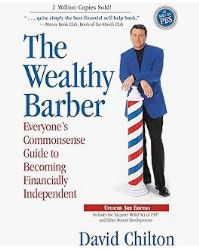 Click on the book to buy on Amazon
Click on the book to buy on Amazon
"The Wealthy Barber" by David Chilton is a personal finance
classic that presents timeless principles of wealth building in a
fictional narrative format. Through the engaging story of three
young adults seeking financial advice from their barber, Chilton
delivers practical wisdom on saving, investing, and achieving
financial independence. Here's a detailed summary of the key
concepts and chapters:
Introduction: Meeting the Wealthy Barber
The book opens with the characters meeting the Wealthy Barber,
who shares his financial wisdom with them over regular visits to his
barbershop. The Wealthy Barber introduces the concept of paying
yourself first and emphasizes the importance of saving and investing
for the future.
Part 1: Pay Yourself First
Chapter 1: The Golden Rule of Personal Finance
The Wealthy Barber introduces the golden rule of personal finance:
pay yourself first. He explains how saving a portion of one's income
before paying expenses is the key to building wealth over time.
Chapter 2: Setting Financial Goals
In this chapter, the characters learn about the importance of
setting financial goals and creating a plan to achieve them. The
Wealthy Barber emphasizes the need for clear, specific goals and
provides guidance on how to prioritize and track progress towards
them.
Chapter 3: Making Time Your Ally
The Wealthy Barber discusses the power of compound interest and
the importance of starting to save and invest early in life. He
explains how even small contributions to savings can grow
significantly over time with the magic of compounding.
Part 2: The Ten Percent Solution
Chapter 4: The Ten Percent Solution
The characters learn about the ten percent solution, which
involves saving and investing ten percent of one's income. The
Wealthy Barber explains how this simple strategy can lead to
financial independence over time.
Chapter 5: Budgeting Basics
In this chapter, the Wealthy Barber discusses the basics of
budgeting and money management. He provides practical tips for
creating a budget, tracking expenses, and living within one's means.
Chapter 6: Managing Debt
The Wealthy Barber explains the dangers of debt and the
importance of managing it responsibly. He discusses strategies for
paying off debt, avoiding high-interest loans, and staying out of
debt in the future.
Part 3: Investing for the Future
Chapter 7: The Road to Wealth
The characters learn about the different investment options
available to them, including stocks, bonds, and real estate. The
Wealthy Barber explains the principles of diversification, risk
management, and long-term investing.
Chapter 8: Building a Solid Investment Plan
In this chapter, the Wealthy Barber helps the characters develop
a solid investment plan based on their financial goals and risk
tolerance. He discusses the importance of asset allocation,
rebalancing, and staying disciplined during market fluctuations.
Chapter 9: Protecting Your Wealth
The Wealthy Barber discusses the importance of protecting one's
wealth through insurance and estate planning. He explains the
different types of insurance coverage available and offers guidance
on selecting the right policies for individual needs.
Conclusion: The Path to Financial Independence
The book concludes with the characters reflecting on the valuable
lessons they've learned from the Wealthy Barber. They commit to
implementing his advice and taking control of their financial
futures, knowing that financial independence is within their reach
with dedication and discipline.